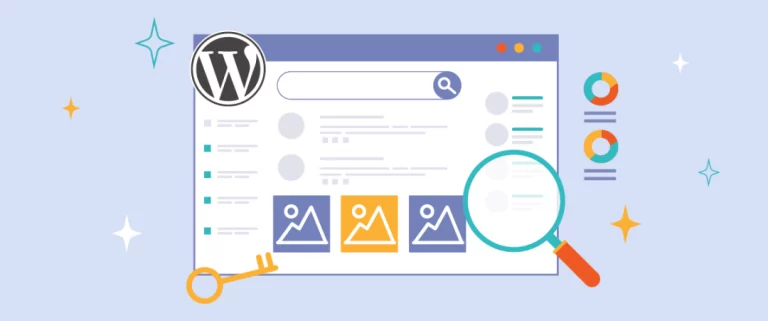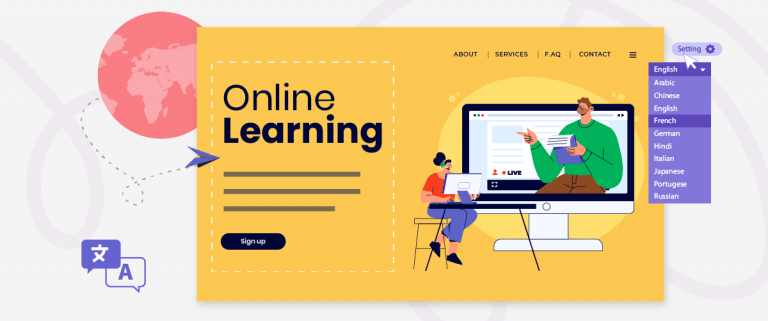Are you looking to find out how to get more visitors to your website? Every website owner naturally wants to attract as much traffic as possible.
They are striving to get a lot of traffic and trying various methods. This is because the more visitors, the greater the potential for conversion of your products. This is the ultimate goal of any business.
Although only some visitors may purchase your product, they have the potential to return in the future and become more familiar with your site and products. Therefore, it is important to increase your website traffic.
So, how do you do it? This article will comprehensively discuss what tips you can apply to your website. Let’s get started!
What’s the benefit of increased website traffic?
Increasing website traffic can provide several key benefits for online businesses, including.
- Higher conversion opportunities: The more visitors come to your website, the greater the chance of converting them into customers or generating sales.
- Increased brand awareness: Boosting traffic means more people will become aware of your brand and products/services. This can help enhance brand awareness and strengthen your position in the market.
- A better understanding of the audience: With more visitor data, you can gain a deeper understanding of your audience, their preferences, and behaviors. This data can be utilized to optimize your marketing strategies and content to target your audience better.
- Greater monetization opportunities: For personal or business websites, the more traffic you have, the more valuable your website becomes. Therefore, this can open up opportunities for additional revenue through advertising, sponsorship, or affiliate programs.
Challenges of increasing your website traffic
Meanwhile, despite offering several benefits, there are some challenges you should be aware of in your efforts to increase website traffic. Here are some of them.
- Intense competition: Numerous websites are vying for the attention of the same audience. This will require extra effort to make your site stand out among the competition.
- Search engine algorithm updates: Search engines like Google often update their algorithms periodically. This makes optimization strategies subject to change; what may be effective today could become less effective tomorrow.
- Variety of online marketing strategies: There are many online marketing strategies, such as SEO, content, social media, advertising, etc. Determining the right combination for your business requires time and extensive experimentation.
- Content creation and consistency: To attract and retain traffic, you must continually produce new content that is of high quality, engaging, and useful to your audience. Maintaining consistency can often be a challenge, especially for personal websites.
18 tips on how to increase website traffic
Although there are challenges, increasing website traffic remains crucial. It requires commitment, the right strategies, and patience to optimize and gradually increase traffic continually. Without further ado, here are some ways to increase your website traffic.
Focus on your niche
Focusing on a specific niche or field is a crucial strategy for increasing website traffic. By targeting a specific and less competitive niche, you can more easily establish yourself as an expert in that area. This will enhance credibility, attractiveness, and trust among the audience interested in that niche.
This approach is more efficient than trying to create content on all topics but in small quantities. For example, if you have a women’s skincare product business, create blogs/articles about usage tips, recommendations, skincare tips, and more. This way, your customers will feel assisted by these contents.
Here are some ways to research and choose the right niche for your website.
- If your website is a business website, align the niche with the business or products you sell. If it’s a personal website, you can start with a niche you are passionate about.
- After determining the niche, assess the competition from websites with similar niches. Is the competition strong, or can you still catch up?
- Conduct surveys among the audience regarding their interests or the content topics they need.
Research your target keyword and search volume
After determining the niche, identify the target international keywords for your content. Researching relevant keywords and their monthly search volumes is crucial for optimizing SEO so that your content is more easily found on search engines like Google.
To view the search volume of a keyword, you can use SEO tools such as Semrush, Ahrefs, Google Keyword Planner, and many more.
The higher the search volume, the more frequently the keyword is searched by users, but the competition is also more challenging.
Carefully examine the search results and select keywords that are relevant to your website. Here is an example of search volume results using the Ubersuggest tool.
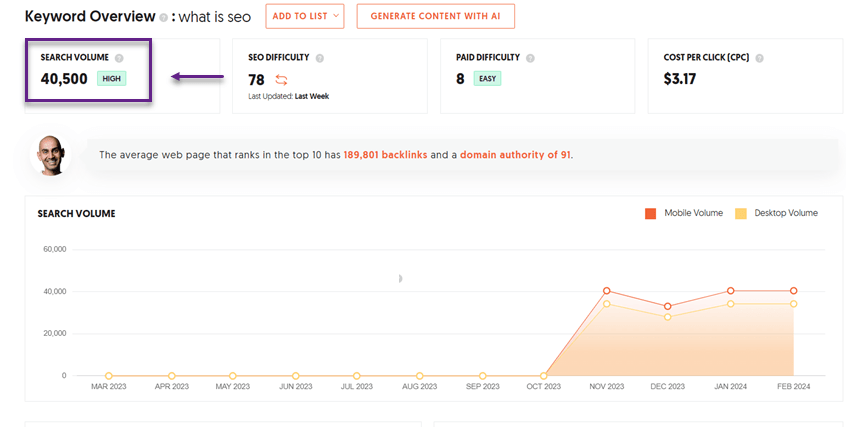
Translate the website into multiple languages
The last tip is to translate your website into various languages. By translating your content into multiple languages, you can reach a broader market share and allow users from different countries or language backgrounds to access and understand the information presented more quickly.
This not only helps increase the number of visitors to your site but also improves user retention and interaction with your site, as users tend to prefer content presented in their native language.
The importance of choosing a translation service to create a multilingual website should not be overlooked. Translation services such as Linguise, which are integrated with various CMS platforms and provide numerous languages and excellent features, can be a beneficial option.
With Linguise, you can translate content into over 80 languages and translate it automatically and quickly with high-quality results. You can also use the outstanding live editor feature to edit translations alongside translators manually.
Create content from other content gaps
In the competition to gain traffic and achieve good search engine rankings, it’s important to identify gaps or topics that your competitors haven’t thoroughly covered. This step allows you to fill those gaps with comprehensive and engaging high-quality content.
Here are some methods to identify content gaps in your competitors.
- Read through each of your competitor’s articles based on the target keywords you intend to use, then identify what subtopics are already covered and which ones are not.
- Another method is to research your audience’s needs and challenges related to your niche that other competitors haven’t addressed well.
- Many SEO tools, like Ahrefs, SEMrush, etc., provide a “Content Gap” feature to identify areas of content that your competitors haven’t covered.
Once you’ve identified the content gap, start creating in-depth, high-quality content to fill those voids. This could include comprehensive guides, detailed case studies, in-depth video tutorials, and more.
Optimize your on-page content
Optimizing on-page content is a crucial factor in improving search engine rankings and traffic. Here are the on-page SEO elements that need to be optimized.
- Title tag
- Meta description
- Heading tags (H1, H2, H3, etc.)
- Text content
- Image size and ALT attributes
- Internal links
- SEO-friendly URL
- Content structure & hierarchy
Optimizing these elements helps search engines better understand the content and purpose of your page. Consequently, this can increase relevance and the likelihood of search engines recommending your page to users based on the target keywords.
Add FAQ Question on your content
The next tip is to add FAQs because they are more specific, making it easier to capture relevant searches for your content. People usually have many questions when searching for a topic. And you’re likely to answer most of those questions within your content. However, there are sometimes questions that are difficult to incorporate into the main content naturally.
To address this, you can add FAQs at the end of your article. This has the potential to help your content rank for more long-tail keywords and gain more search traffic.
For example, if you’re targeting the keyword “what is SEO”, instead of just discussing that, you could add the search keyword “how can I start SEO as a beginner”, which might be searched by people interested in becoming an SEO specialist. If you can’t naturally insert these keywords into the main content, the solution is to create FAQs and include these questions, then answer them.
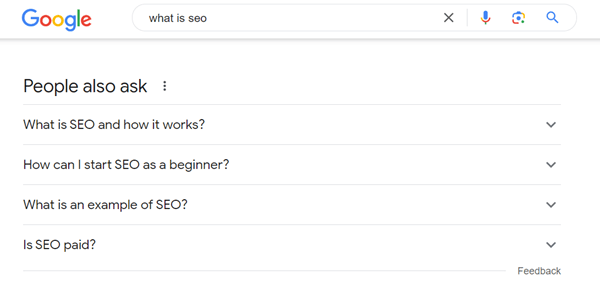
So, when a user selects these keywords in the “people also ask” column, your website will immediately appear with a short answer preview.
Share your content on social media
Sharing your content on various social media platforms is a crucial strategy to reach a wider audience and encourage content dissemination through your personal follower accounts. However, social media presence isn’t just about sharing article links; it’s also about building personal branding. With a solid personal brand, your audience will trust you more.
It’s recommended to start with one or two profiles on networks that are most suitable for the type of content published on your website.
Here’s an example of sharing a web article about SEO on Twitter. When sharing content on social media, make sure to provide a brief description of the content, include an image, and, most importantly, include a link to the content page.
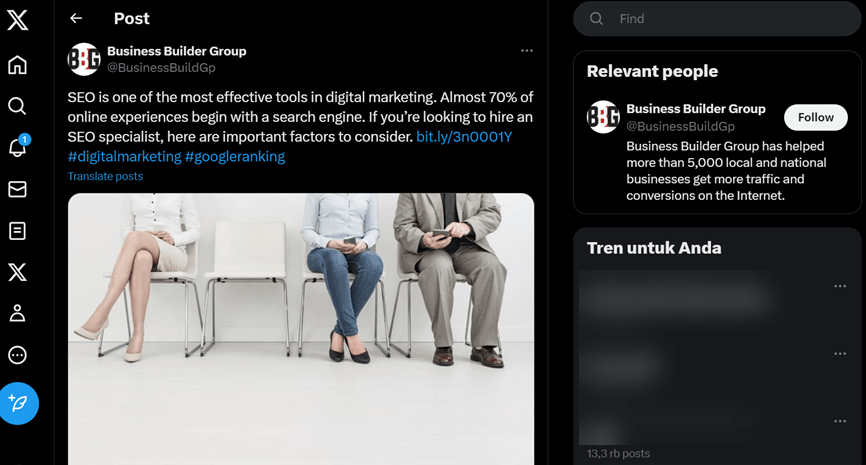
Collaborate with influencers in your niche
Influencers are individuals who have a significant following and robust influence within specific communities. By collaborating with them, you can leverage their credibility and reach to promote your content.
There are several ways you can collaborate with influencers, such as creating content together (videos, podcasts, etc.), inviting them for interviews on your platform, or having them recommend your products/services to their audience. Influencers can help you reach new audience segments who may not have been exposed to your content or brand before.
If a reputable and trusted influencer recommends your content or product, audiences are more likely to be interested in and trust what you offer. This can build positive relationships with new audiences and increase brand awareness.
Here are some important considerations when choosing influencers to collaborate with.
- Ensure that the influencer you choose operates in the same niche or field as your business/content.
- Don’t just look at the number of followers; pay attention to their engagement rate as well. Evaluate the quality of the content produced by the influencer.
- Find out the influencer’s reputation within their community.
- They should have good storytelling skills to engage their audience with compelling and authentic content.
- Review the offers and fees they provide to ensure they align with your budget and goals.
Update the content regularly
Regularly updating content is crucial to maintaining relevance and ranking positions in search engines. If you currently have a good ranking for target keywords, competitors may steal that position, or Google may downgrade your ranking when the content is not regularly updated.
Therefore, you need to continue updating content periodically to maintain your ranking. Regularly updating content will also ensure that your audience always receives the latest information. Updated content provides added value, ensuring that visitors do not turn to competitor sites.
You can also leverage content updates to reshare them on social media or send notifications to subscribers. The more diligent you are in updating, the greater the chances of your content maintaining a high rank.
Reformat your content into other social media
Reformatting means summarizing or transforming blog article content into a shorter and more visual format, such as carousel posts on Instagram or posts on LinkedIn. This could involve extracting key points from the article and packaging them into engaging images or short videos to capture the audience’s attention.
Below is an example of content reformatting on LinkedIn. The post contains several image slides discussing keywords. Then, the caption is supplemented with a brief description and a link that directs to the content page.
When the audience reads the content and wants to learn more, they will likely click on the link, ultimately generating website traffic.
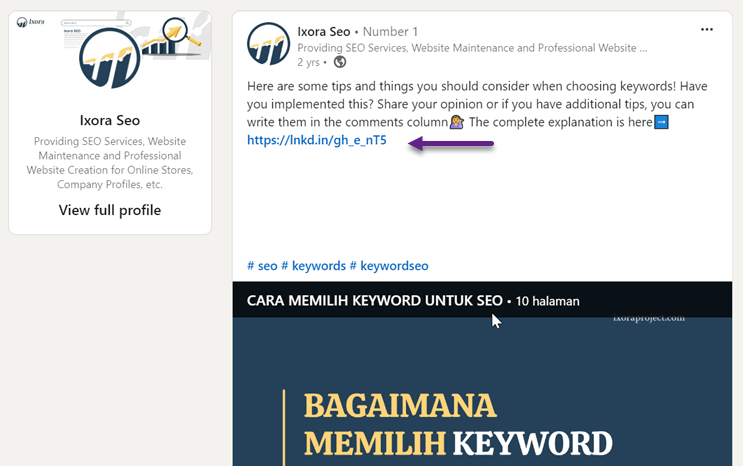
Guest posting on the relevant website
Becoming a guest contributor is one of the proven ways to increase website traffic and brand awareness.
This method benefits both parties involved. For new website owners, being a guest contributor provides the opportunity to obtain links from other sites. This can assist in SEO efforts and attract more users to visit your site. On the other hand, the recipients of guest posts they will receive free content that can be published directly on their website.
However, there are two types of guest posts: free and paid. Paid guest posts are typically for websites that are already large-scale and have hundreds of thousands of visitors each month.
Here are some things to consider when doing guest posting.
- Ensure that the site you choose to be a guest contributor is relevant to your niche or topic.
- Provide high-quality content when doing guest posting and follow the applicable content rules.
- Pay attention to the linking policies of the site you are targeting.
- Communicate clearly and politely with the site owner.
- Determine your goals in doing guest posting, whether it’s to build authority in your industry, expand your reach, etc.
Using local SEO by creating GBP
Implementing local SEO and optimizing your Google Business Profile (GBP) is a crucial step in your local marketing strategy. By ensuring that your Google business profile is filled out, you not only increase the likelihood of appearing in local search results but also ensure that potential customers get accurate and complete information about your business.
With complete and accurate information, customers are more likely to find and choose your business over local competitors.
Here are the points that should be optimized in your Google Business Profile (GBP) or general Local SEO efforts.
- Input basic information such as address, phone number, and business hours.
- Add an informative and engaging business description with relevant keywords.
- Include attractive and high-quality images to grab users’ attention.
Below is an example of the Google Business Profile display on a search engine when searching for hotels in Bali, Indonesia. The left-hand side shows the GBP display. If users are interested in the hotel, they may visit the hotel’s website.
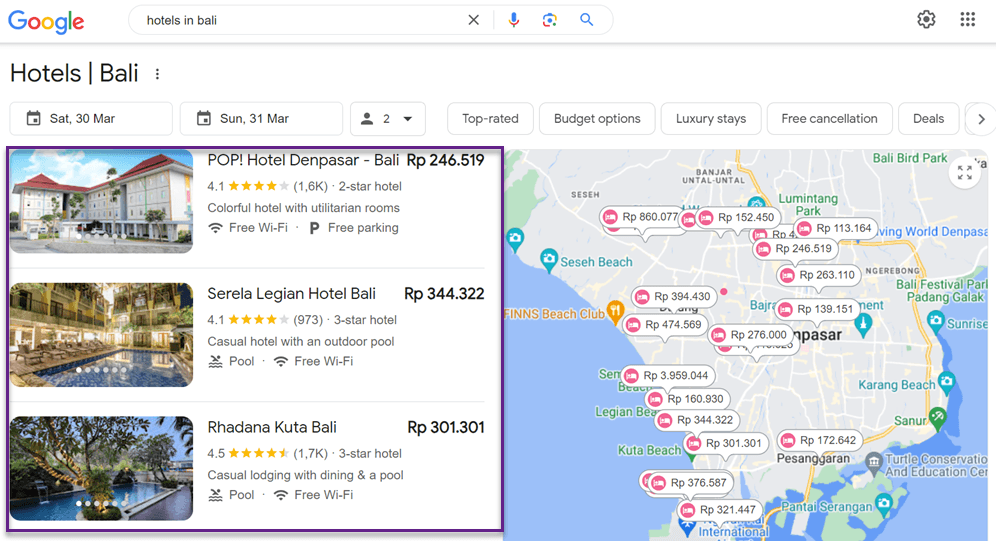
Build customer relationships with newsletters
Building relationships with customers through newsletters is one of the effective ways to maintain connections with the audience. By sending regular email newsletters, they have the potential to open them immediately or at a later time.
Email newsletters can be used to deliver useful information and promotions, such as sales or special events. You can direct the audience to your website to read articles or take advantage of the offers provided.
Here is an example of a newsletter from Linguise sent to users’ emails. The newsletter contains a button that directs users to the Linguise website page.
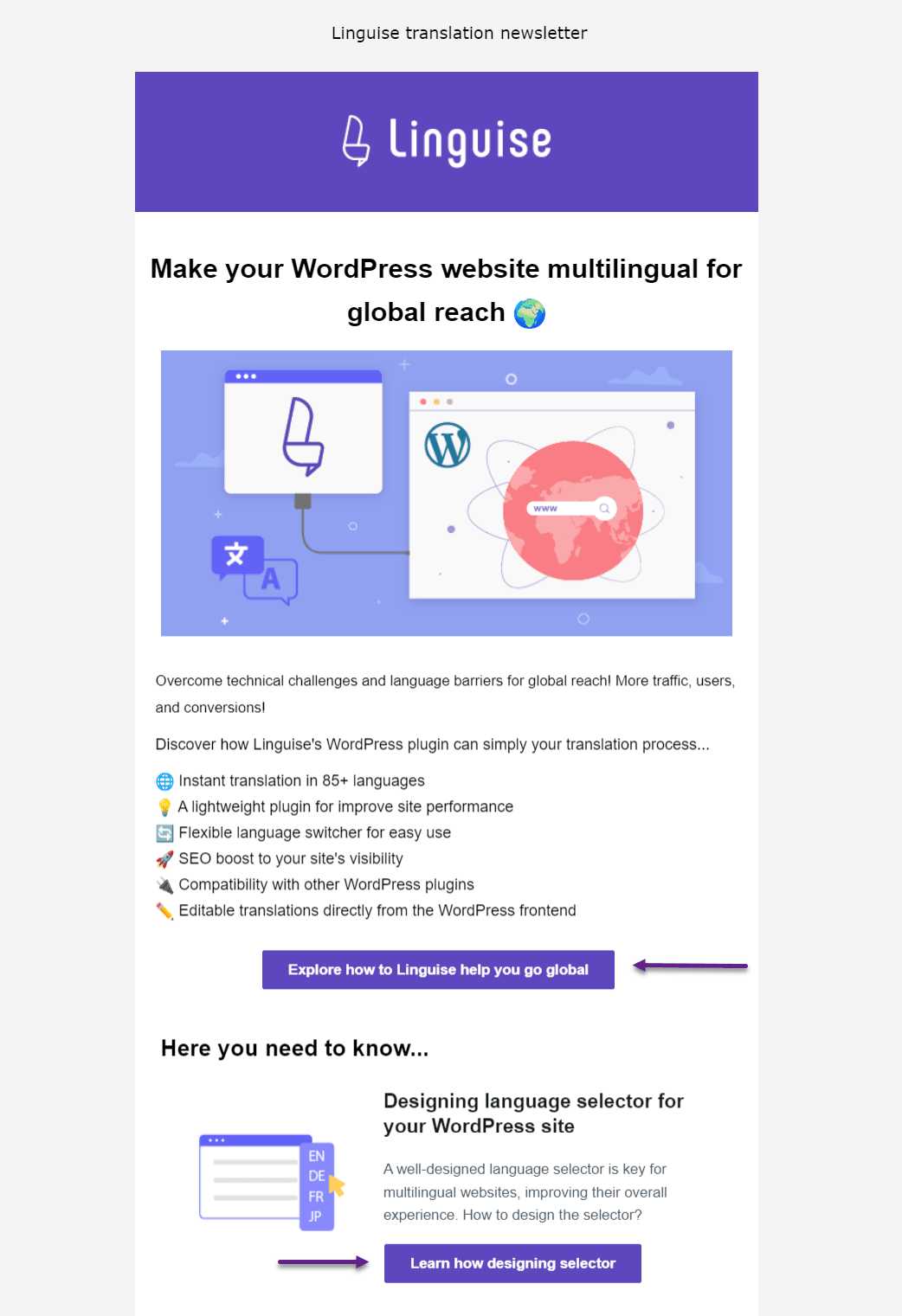
Create affiliate or referral programs
The next tip to increase website traffic is to create an effective affiliate program to expand the reach of your website organically.
In many cases, affiliate programs are quite straightforward. You can pay partners for every successful purchase made through their promotions. Many service providers and tools you use, including WordPress hosting providers, offer affiliate programs.
One of the main advantages of affiliate programs is that they not only help you gain more traffic but also direct conversions. By paying reasonable fees to partners, they will be motivated to promote your products or services vigorously.
The more people who join, the more traffic will flow to your website.
Social share buttons
Social media share buttons are an essential feature for every website, as they facilitate the process of sharing content quickly and easily. By installing social media share buttons on your website, visitors can easily share content they find interesting with their social networks, such as Facebook, Twitter, or LinkedIn.
Moreover, these buttons help you track how much your content is being shared across various social platforms, providing valuable insights into the types of content that are most popular among your audience.
Here is an example of a website that uses social share buttons on its content pages.

Participate on the QnA website
Participating in question-and-answer sites is one effective strategy to build your authority and expand your reach organically. Q&A sites like Quora or Reddit provide platforms where you can interact directly with audiences interested in specific topics or fields.
However, it’s important to note that question-and-answer sites like Reddit have a culture sensitive to marketing. Therefore, it’s crucial to pay attention to the following when sharing there.
- Avoid posting content that is irrelevant or too far from the topic being discussed.
- Strive to provide detailed and helpful answers to readers.
- Avoid overly promoting yourself directly.
- Understand and adhere to the rules and policies of each platform carefully and avoid violating rules or spamming.

Build high-quality backlink
Create high-quality backlinks or international links building is key to increasing your site’s authority in search engines. Quality backlinks are more important than quantity because links from relevant websites can provide greater added value.
High-quality backlinks can improve your site’s ranking in search engines, enhance consumer trust, and expand brand awareness. Make sure to obtain backlinks from trusted and relevant sites, as backlinks from less trustworthy sites can have a negative impact on your site’s ranking and reputation.
When reputable websites link to yours, it signals to search engines that your content is valuable and trustworthy. As a result, your site’s ranking improves, driving more organic traffic to your pages. Additionally, backlinks from authoritative sources lend credibility to your brand, positioning your business as a competent and reliable entity in your industry.
Some tips for building high-quality backlinks include:
- Identify websites linking to your competitors and explore opportunities to obtain backlinks from the same sources.
- Share valuable content on social media platforms, industry forums, and relevant online communities to increase its visibility and attract backlinks.
- Identify broken links on websites within your niche and offer to replace them with links to your relevant and informative content.
- Use tools to track where your brand is mentioned online and politely reach out to website owners, requesting them to include backlinks to your site.
Community building
Building a community around your niche, such as on Facebook, helps strengthen your brand, increase engagement, and expand your reach.
An active community allows you to interact with your audience, gather valuable feedback, and gain insights into their needs and preferences. This knowledge can then be used to create content tailored to your target audience, further strengthening the bond between your brand and your community.
Here, you can share articles you’ve created, and don’t forget to include links. This is where you will generate website traffic.
To build a successful Facebook community around your niche, encourage discussions, ask thought-provoking questions, and actively participate in conversations. Share your content, but also be open to learning from members of your community. Create a friendly and inclusive environment where everyone feels comfortable sharing their thoughts and experiences.
Additionally, consider live events, Q&A sessions, or webinars within your Facebook community. These interactive experiences not only provide valuable content but also help strengthen the sense of community and maintain member engagement.
This is an example of a community page or group on GoDaddy’s Facebook. They often share article content, promos, or events that will be held.
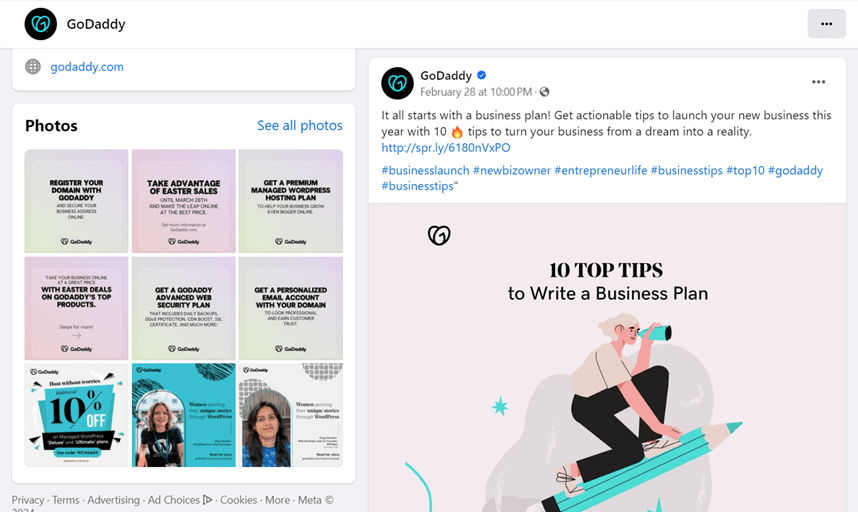
Conclusion
Now you know what efforts you can take to increase website traffic. Some methods include focusing on niche, keyword research, creating audience-centric content, collaborating with influencers, and leveraging affiliate programs.
Despite challenges such as fierce competition and search engine algorithm changes, increasing website traffic remains crucial for the success of online businesses. It requires commitment, the right strategy, and patience to continuously optimize and increase traffic gradually.
One effective strategy is to utilize translation services like Linguise to translate your website into various languages. By translating your content, you can reach a global audience, expand your market reach, and ultimately increase website traffic.
Linguise offers outstanding features and integrations that streamline the translation process and provide high-quality translation results. So why not register for a Linguise account and translate your website for free for 30 days to experience using the service!



